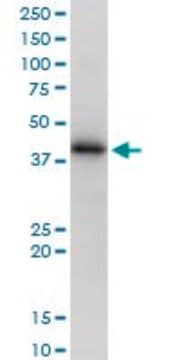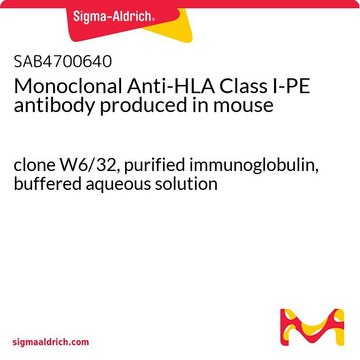F5662
Monoclonal Anti-HLA Class I Antigen−FITC antibody produced in mouse
clone W6/32, purified immunoglobulin, buffered aqueous solution
Synonyme(s) :
Monoclonal Anti-HLA Class I Antigen
About This Item
Produits recommandés
Source biologique
mouse
Conjugué
FITC conjugate
Forme d'anticorps
purified immunoglobulin
Type de produit anticorps
primary antibodies
Clone
W6/32, monoclonal
Forme
buffered aqueous solution
Espèces réactives
monkey, human
Technique(s)
direct immunofluorescence: 1:10 using acetone-fixed human tonsil frozen sections.
flow cytometry: 10 μL using 1 × 106 cells
Isotype
IgG2a
Numéro d'accès UniProt
Conditions d'expédition
wet ice
Température de stockage
2-8°C
Modification post-traductionnelle de la cible
unmodified
Informations sur le gène
human ... HLA-A(3105) , HLA-B(3106) , HLA-C(3107)
Vous recherchez des produits similaires ? Visite Guide de comparaison des produits
Description générale
The previously assigned protein identifier P01892 has been merged into P04439. Full details can be found on the UniProt database.
Spécificité
4th Workshop: code no. P1
5th Workshop: code nos. BP166, BP288, BP407, B 005
Immunogène
Application
- flow cytometric analysis
- immunoprecipitation
- complement mediated cytotoxicity
- immunocytochemistry
Forme physique
Notes préparatoires
Clause de non-responsabilité
Vous ne trouvez pas le bon produit ?
Essayez notre Outil de sélection de produits.
Code de la classe de stockage
10 - Combustible liquids
Classe de danger pour l'eau (WGK)
nwg
Point d'éclair (°F)
Not applicable
Point d'éclair (°C)
Not applicable
Équipement de protection individuelle
Eyeshields, Gloves, multi-purpose combination respirator cartridge (US)
Faites votre choix parmi les versions les plus récentes :
Déjà en possession de ce produit ?
Retrouvez la documentation relative aux produits que vous avez récemment achetés dans la Bibliothèque de documents.
Notre équipe de scientifiques dispose d'une expérience dans tous les secteurs de la recherche, notamment en sciences de la vie, science des matériaux, synthèse chimique, chromatographie, analyse et dans de nombreux autres domaines..
Contacter notre Service technique








